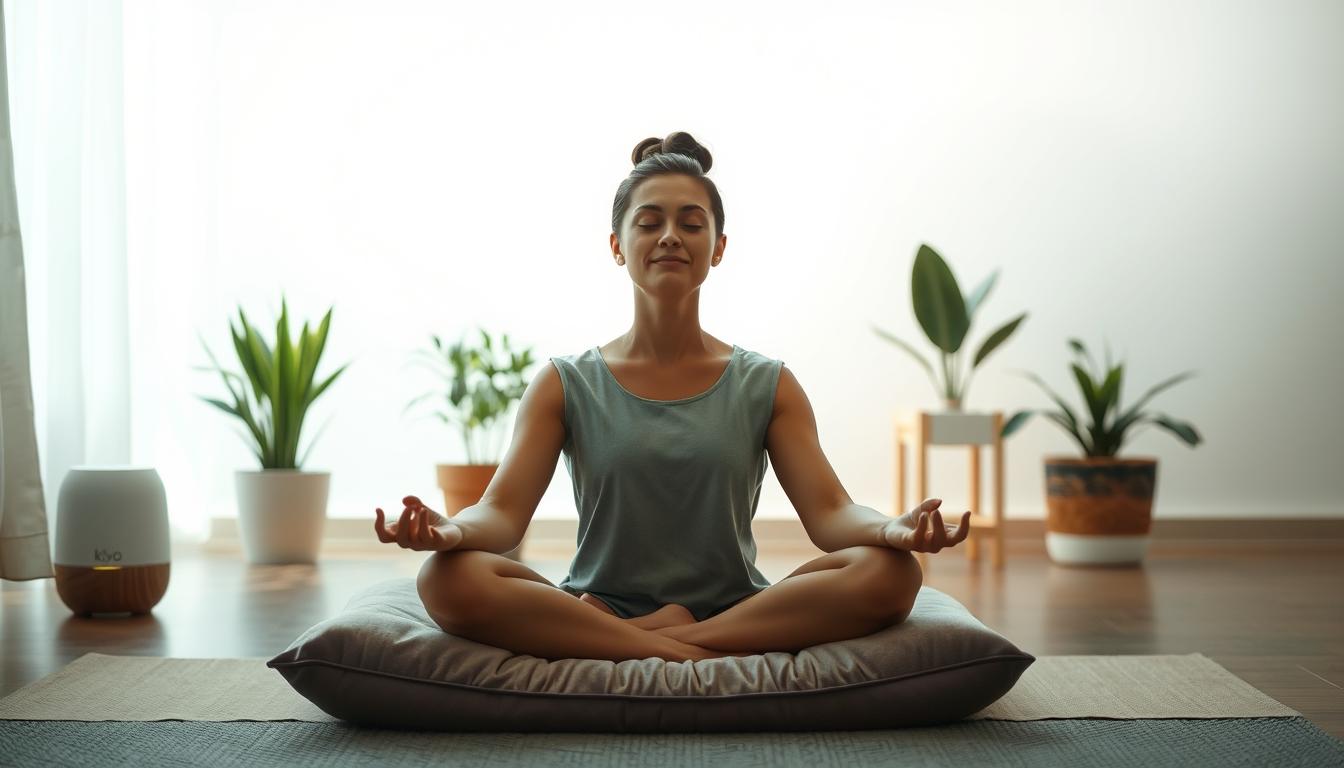I am a participant in the Amazon Services LLC Associates Program, an affiliate advertising program designed to provide a means for sites to earn advertising fees by advertising and linking to Amazon.com and affiliated sites. This post contains affiliate links. Privacy Policy
How to Manage Anxiety: Tips and Strategies
Do you feel constantly uneasy and worried without a break? Anxiety can really take over, affecting your life in many ways. Learning how to manage anxiety is a big step towards feeling better.

You’re not the only one dealing with this. Millions of people around the world face anxiety. It’s a common issue that needs attention and care. To cope with anxiety, you can try self-help, make lifestyle changes, and seek professional help when needed.
Discovering ways to reduce anxiety can greatly improve your life. This article will show you different techniques to manage anxiety effectively.
Best brain supplement!
Key Takeaways
- Understanding anxiety is crucial for effective management.
- Various techniques can help alleviate anxiety symptoms.
- Lifestyle changes play a significant role in anxiety relief.
- Professional help is available and often necessary.
- Practicing self-help strategies can empower you to manage anxiety.
Understanding Anxiety and Its Impact
Understanding anxiety is key to managing it. It’s not just feeling stressed or overwhelmed. It’s a complex condition with many forms.
Common Symptoms of Anxiety
Anxiety can show up as physical symptoms like a racing heart or sweating. You might also feel fear, worry, or apprehension that won’t go away. Other signs include trouble focusing, feeling irritable, and having trouble sleeping.
Some people feel anxiety mostly in their body, while others feel it more in their mind. Knowing how you experience anxiety helps you find ways to cope better.
Types of Anxiety Disorders
There are many types of anxiety disorders. Generalized Anxiety Disorder (GAD) is when you worry too much about everyday things. Panic Disorder is when you have panic attacks over and over.
Social Anxiety Disorder makes you fear being in social situations. Phobias are intense fears of specific things or situations. Each type has its own unique traits.
| Anxiety Disorder | Characteristics |
|---|---|
| Generalized Anxiety Disorder (GAD) | Excessive worry about everyday things |
| Panic Disorder | Recurring panic attacks |
| Social Anxiety Disorder | Fear of social or performance situations |
The Physical and Mental Effects of Chronic Anxiety
Living with chronic anxiety can harm your body and mind. It can cause heart problems, digestive issues, and weaken your immune system. It can also lead to depression, burnout, and make you less resilient.
You don’t have to face anxiety alone. The Anxiety and Depression Association of America says, “Anxiety disorders are treatable, and treatment can be very effective.”
Immediate Strategies to Manage Anxiety
Anxiety can feel overwhelming, but there are quick ways to take back control. It’s key to have strategies that calm your mind and body. These methods are simple, effective, and easy to add to your daily routine.
Deep Breathing Techniques
Deep breathing is a strong tool against anxiety. It calms your nervous system and lowers panic. To do it, breathe slowly in through your nose, hold for a few seconds, and then breathe out slowly through your mouth.
“The way you breathe has a big impact on how you handle stress,” says a mindfulness expert. “Changing your breathing can calm your mind and lessen anxiety.”
Grounding Exercises for Panic Attacks
Grounding exercises are great for managing anxiety, especially during panic attacks. They keep you in the present moment, away from anxious thoughts. Try noticing your feet on the ground, the sounds around you, or the air on your skin.
Mindfulness Practices for Present-Moment Awareness
Mindfulness helps you stay in the now, focusing on the present. You can practice it through meditation or mindful movement like yoga. Regular mindfulness can lower your anxiety levels.
Jon Kabat-Zinn, a mindfulness leader, said, “The best way to care for the future is to care for the present moment.” This shows how crucial mindfulness is for managing anxiety.
Progressive Muscle Relaxation and Body Scanning
Progressive muscle relaxation involves tensing and relaxing muscles. It helps release tension linked to anxiety. Start by tensing your toes, holding for a few seconds, and then releasing. Move up your body, tensing and relaxing each group.
Body scanning is similar. It involves noticing sensations in your body, often while lying down or sitting. By focusing on different body parts, you can release tension and relax.
Lifestyle Changes for Long-Term Anxiety Management
Managing anxiety isn’t just about quick fixes. It’s about making lasting lifestyle changes. By adding healthy habits to your daily life, you can better handle anxiety and feel better overall.
Regular Physical Exercise and Its Benefits
Exercise is key for managing anxiety. It releases “feel-good” hormones called endorphins. You don’t need to run marathons. Just walking, cycling, or swimming for 30 minutes a day can help a lot.
Nutrition and Diet Considerations
What you eat affects your anxiety. Eating a balanced diet with whole foods, fruits, veggies, and lean proteins can help your mood. Watch how certain foods might make you feel anxious.
Foods That May Trigger Anxiety
Some foods can make anxiety worse. These include:
- Caffeine: Too much caffeine can make your heart race and trigger anxiety.
- Sugary foods: Eating too much sugar can cause energy crashes and mood swings.
- Processed foods: Foods high in salt and unhealthy fats can harm your health and increase anxiety.
Anxiety-Reducing Foods and Supplements
Some foods and supplements can help with anxiety. These include:
- Omega-3 rich foods: Fatty fish, nuts, and seeds support brain health.
- Complex carbohydrates: Whole grains can boost serotonin, making you feel calmer.
- Herbal teas: Teas like chamomile and lavender can be soothing.
Sleep Hygiene Practices
Good sleep is vital for managing anxiety. Bad sleep can make anxiety worse. Try to sleep the same hours every night, have a calming bedtime routine, and avoid screens before bed.
Daily Stress Management Techniques
It’s important to manage daily stress to keep anxiety under control. Mindfulness meditation, journaling, and setting healthy boundaries can help. Also, take breaks and do things that make you happy and relaxed.
By making these lifestyle changes, you can manage anxiety better and improve your life quality.
How to Manage Anxiety Through Cognitive Approaches
Managing anxiety needs a mix of strategies, with cognitive methods being key. These approaches help change thought patterns that lead to anxiety. This way, people can better handle their anxiety.
Cognitive Behavioral Techniques
Cognitive Behavioral Therapy (CBT) is a proven way to tackle anxiety. It helps by spotting and changing negative thoughts to more positive ones.
Identifying Anxious Thought Patterns
The first step in CBT is to notice your thoughts, especially the anxious ones. Keep a thought diary to track when you feel anxious, what you think, and how you feel.
Challenging Cognitive Distortions
After spotting anxious thoughts, it’s time to question them. Ask if there’s real proof for these thoughts. Look for more positive views.
Developing Positive Coping Statements
Change negative thoughts into positive affirmations. Say “I’ve prepared well, and I’ll do my best” instead of “I’m going to fail.” This reduces anxiety and boosts your mood.
Journaling and Self-Reflection Practices
Journaling is a great tool for managing anxiety. It helps you understand your thoughts and feelings. It also shows your progress over time. Regular journaling improves your self-awareness and anxiety understanding.
Setting Healthy Boundaries in Relationships
Setting and keeping healthy boundaries is vital for anxiety management. It means clearly telling others what you need and standing up for your limits. It also means taking care of yourself. This reduces anxiety caused by others and builds better, less stressful relationships.
Using these cognitive strategies daily can help you manage anxiety better. It improves your overall well-being.
Conclusion: Creating Your Personal Anxiety Management Plan
You now know a lot about anxiety and how to manage it. To beat anxiety naturally, mix anxiety relief tips, stress management, and natural remedies into your day. This will help you feel better.
Try deep breathing, grounding exercises, mindfulness, and exercise to build a strong plan. Doing these regularly can help you control anxiety and boost your health.
Make a plan that fits you by picking what works best and doing it every day. This way, you’ll be ready to face anxiety and live a more balanced life. Start your journey to a calmer, healthier you today.
FAQ
What are some effective techniques for managing anxiety?
Deep breathing, progressive muscle relaxation, and mindfulness can help manage anxiety. Cognitive-behavioral therapy (CBT) and journaling are also good strategies. They help reduce anxiety symptoms.
How can lifestyle changes impact anxiety management?
Regular exercise, a balanced diet, and good sleep are key. Avoiding foods that trigger anxiety is also helpful. Adding anxiety-reducing foods and supplements can make a difference.
Can cognitive approaches help in managing anxiety?
Yes, cognitive approaches like CBT, journaling, and self-reflection can manage anxiety. It’s important to challenge anxious thoughts and use positive coping statements.
What role does stress management play in anxiety relief?
Stress management is crucial for anxiety relief. Mindfulness, relaxation exercises, and setting healthy boundaries help. These techniques can reduce anxiety levels.
Are there any natural remedies that can help alleviate anxiety?
Certain herbal supplements and essential oils may help with anxiety. But, always talk to a healthcare professional before trying new remedies.
How can I develop a personal anxiety management plan?
To create a personal plan, first identify your anxiety triggers and symptoms. Then, explore different techniques like those in this article. Find what works best for you. Combine these strategies into a plan tailored to your needs.
I am a participant in the Amazon Services LLC Associates Program, an affiliate advertising program designed to provide a means for sites to earn advertising fees by advertising and linking to Amazon.com and affiliated sites. This post contains affiliate links. Privacy Policy


